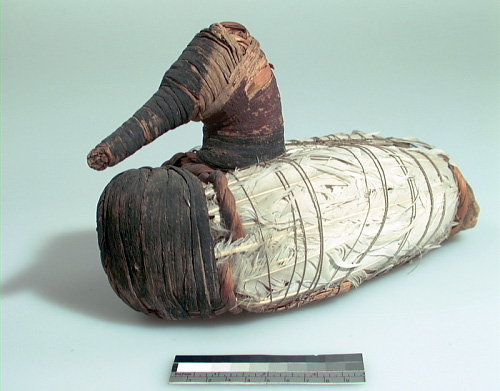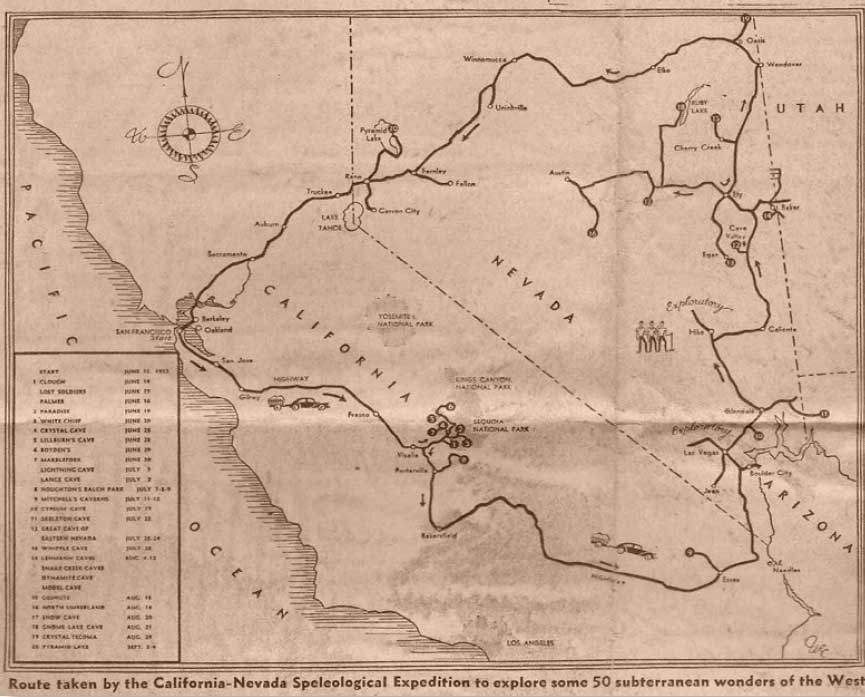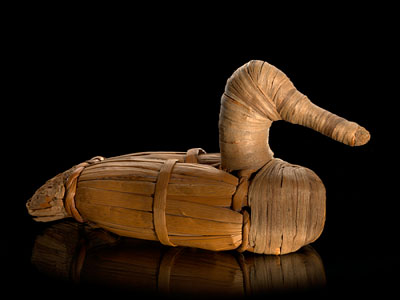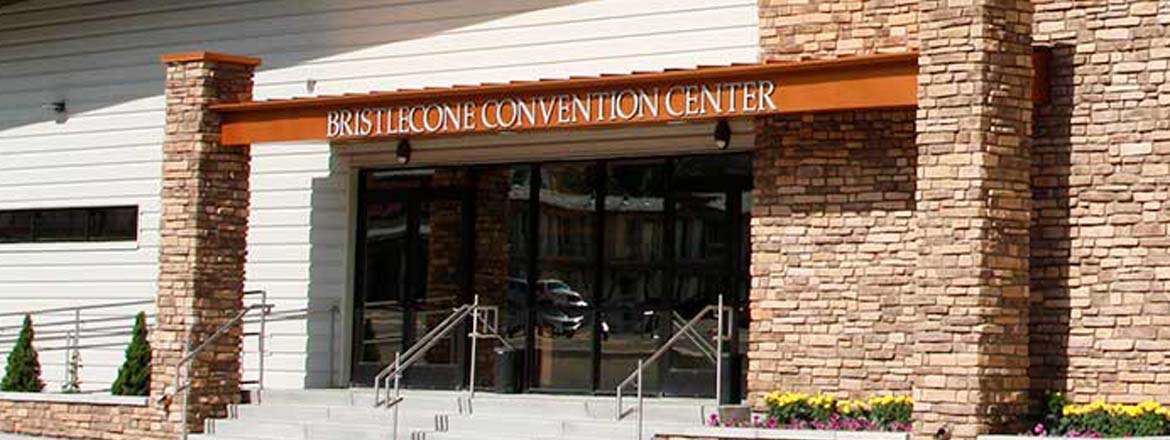

Duck decoy, Middle Desert Archaic Tradition - Found in Lovelock Cave; Churchill County, Nevada. National Museum of the American Indian.
Read MoreArchaeologists have found evidence of early man using caves and shelters across the entire state of Nevada. In the 1930s, the Southwest Museum conducted excavations in Gypsum Cave (Clark Co.) and found that there was human habitation in the cave that dates to around 3000 BC. This would appear to be the earliest recorded cave visitation in the state.
Gnome Lake Cave (Elko Co.) was likely the first cave known to the early white settlers in Nevada as names with 1850 dates have been found. It has been rumored that the Donner party stopped here in 1846.
Cave Valley Cave (Lincoln Co.) is probably the most well known cave in Nevada after Lehman Cave. It was explored and surveyed by First Lieutenant George M. Wheeler during the 100th Meridian Survey of the 1860s. Wheeler Peak also bears his name. In 1869, P. W. Hamel (surveyor) and Weyes Thompson (cartographer) surveyed some 2,400 feet and produced a fine map. This may well be the first cave survey in the west. The cave is known for its viscous mud, red clay that was once mined for use in cosmetics.
Video compliments of University of Nevada, Reno
Obviously Lehman Cave (White Pine Co.), the beautiful tour cave in the Snake Range of eastern Nevada is the most publicized cave in the state. The cave was discovered in the spring of 1885 by Absalom S. Lehman. It was made a National Monument on January 24, 1922, and became a part of Great Basin National Park on October 27, 1983.
Although most likely known to various members of the Lake Mojave and Pinto cultures and later Shoshone Indians for several thousand years, Devil's Hole (Nye Co.) was discovered in 1930 and the discovery of pupfish (Cyprinodon diabolis) and deep water put the cave in the media for years. The Southern California Grotto made some of the early scuba explorations in the cave.
It's likely that Whipple Cave (Lincoln Co.) was found shortly after Cave Valley Cave, but the first recorded visit was made in 1885 by local rancher Mike Riodan. Upon hearing of the cave in 1924, and due to the beautiful entrance drop, the large linear passage with large speleothems made the cave a candidate for commercialization. Due to the success at Lehman Cave, owner John Lytle Whipple hired a professional survey team from Ely to survey the cave in 1946. While a nice map was produced, the dream of opening the cave to the public never materialized.
Don Emerson of the Southern California Grotto led a group to Cave Valley Cave and the Lehman Cave area, thus introducing organized speleology to the rich cave area of eastern Nevada. Arthur L. Lange and other Stanford Grotto members visited the Baker Creek Caves in March 1952. It would be Lange's first visit of many.
Video compliments of US National Park Service
The real watershed moment in the history of modern speleology for Nevada occurred during the summer of 1952. The Western Speleological Institute (W.S.I.) was organized in the early 1950s through efforts of the staff at the Santa Barbara Museum of Natural History in California. While archaeology and paleontology became the focus of the Museum in later years, speleologists Arthur L. Lange, Raymond de Saussure, and George Mowat made up most of the staff in 1952. During that summer, the three spent fifteen weeks studying caves in California and Nevada. Their three weeks at Baker Creek started Lange's deep interest in the area which lasted for many years. In 1953, the W.S.I. published "The Report of the California-Nevada Speleological Survey." While the W.S.I. ceased to exist around 1960, the authors of the California-Nevada Survey later formed Cave Research Associates.
Other than the W.S.I., members of the Salt Lake Grotto were the principal investigators of the eastern Nevada Caves in the 1950s. This effort was led by William R. Halliday in the mid-50s with several caves being surveyed and several Technical Notes written. Later in the 50s, Dale Green was the driving force behind the Salt Lake Grotto's Nevada work. Besides leading many trips to the area, he directed the Grotto's NPS contract survey of Lehman Caves.
In the 1960s, the principal groups studying Nevada caves were the Salt Lake Grotto, the Great Basin Grotto (Reno), and the UAAC Grotto (Tucson). Dale Green remained the principal force behind the Salt Lake Grotto's work in eastern Nevada. Alvin McLane was the energy of the Great Basin Grotto and they investigated and surveyed caves throughout the state. Ron Bridgemon led the work of the UAAC Grotto in eastern Nevada and steered the group to further the work of the W.S.I. at Baker Creek. The San Francisco Bay Chapter (SFBC) also made many trips, mostly led by Bruce Rogers, to the area from the 1960s to the 1980s and produced several papers and mapped caves. Rogers then compiled the 1975 Frogtown NSS Convention Guidebook that included many of the Eastern Nevada caves.
It is not possible to discuss Nevada caving history in the 1960s without mentioning Keith A. Trexler. Trexler was the Chief Park Naturalist at Lehman Caves National Monument from 1964 through 1966. He hired cavers as summer guides so that he would have caving partners. He encouraged speleologists to visit the region and conduct research. He assisted in the mapping of several caves with members of the UAAC and Great Basin Grottos. Trexler researched and wrote the definitive history of Lehman Cave and even found Absalom Lehman's signature within the cave. Unfortunately, Keith was killed in an aircraft accident in Alaska shortly thereafter, thus ending an extremely promising caving career.
It's interesting to note that, with the exception of the Salt Lake Grotto and the SFBC, none of the NSS Grottos that worked from the 1950s and into the 1960s still exist.

The official event schedule for the 2025 NCKMS has now been updated. Please check our schedule page or download a PDF to your mobile device.

The Karst Waters Institute is a 501(c)3 nonprofit institution whose mission is to improve the fundamental understanding of karst water systems for professionals and the public.
The institute works to engage professionals in small conferences and workshops to advance karst science; increase recognition and publication of karst science; foster development of karst professionals; and to communicate and disseminate information to the public.
![]() Clear, with a low around 14. South southeast wind around 5 mph.
Clear, with a low around 14. South southeast wind around 5 mph.
![]() Sunny. High near 49, with temperatures falling to around 41 in the afternoon. West wind 0 to 5 mph.
Sunny. High near 49, with temperatures falling to around 41 in the afternoon. West wind 0 to 5 mph.
![]() Partly cloudy, with a low around 17. North northwest wind around 5 mph.
Partly cloudy, with a low around 17. North northwest wind around 5 mph.

Nevada's Lovelock Cave is one of the most important classic sites of the Great Basin archaeological record because conditions of the cave are conducive to the preservation of organic and inorganic material.
In 1911 two miners, David Pugh and James Hart, were hired to mine for bat guano from the cave. They removed a layer of guano estimated to be three to six feet deep and weighing about 250 tons. The miners were aware of the artifacts they were disturbing but, unfortunately, only the most interesting specimens were saved. Archaeologists were quickly alerted to the existence of the cave where they found 11 pre-historic duck decoys stored inside two woven baskets.
The cave was placed on the National Register of Historic Places on May 24, 1984. It was the first major cave in the Great Basin to be excavated.

h2go Essen Vacuum Food Container
It's a double-wall, stainless steel, 17 oz capacity thermos from h2go®. This thing is more rugged than your cave pack! We've been trying to beat up the manufacturer's sample they sent, but it keeps winning. Hot things stayed hot, cold things stayed cold.
And ours will have the cool NCKMS logo printed on it.
